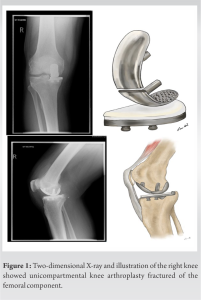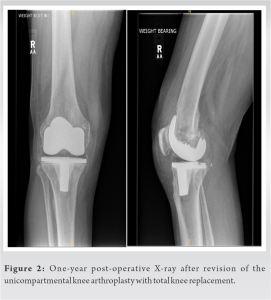There is a chance of an atypical fracture of the UKA component which may be happened unusually.
Dr. Mahmoud Elbakry, Department of Trauma and Orthopaedics, University Hospitals of Derby and Burton NHS Foundation Trust, Derby, United Kingdom. E-mail: dr.mahmoud.elbakry@gmail.com
Introduction: Unicompartmental knee arthroplasty (UKA) is performed with yearly rate of 9% in UK, and <8% in USA. It has been shown to be a successful and less invasive alternative to complete knee arthroplasty in certain patients total knee arthroplasty (TKA). Fracture of the femoral component after (UKA) has never been reported in the literature. Consequently, to investigate the major causes and mechanisms of (UKA) failure, we present a case of femoral component failure following (UKA).
Case Report: A 62-year-old patient with 2 years following an UKA presented with a right pain, stiffness, and gait abnormalities. After taking full history and careful examination and obtaining a new radiograph, a fracture of the femoral component was revealed. A revision surgery with TKA has been done, and the outcome was assessed regularly, and good results were achieved.
Conclusion: The exact reason for a femoral component fracture following UKA is yet unknown. To make an early diagnosis and avoid the need for complex knee revision surgeries, long-term follow-up is crucial for early detection of the clinical signs and symptoms of implant failure.
Keywords:
In recent years, the use of unicompartmental knee arthroplasty (UKA) for the treatment of localized, medial compartmental osteoarthritis of the knee has regained popularity [1]. Many studies have demonstrated that 10 years after a current UKA implant, the survival rate exceeds 90% [2]. Despite this, registry data for knee replacements reveal a somewhat high revision and failure rate for UKA, especially when compared to conventional total knee arthroplasty (TKA) [3]. UKA failures have observable characteristics, in addition to the incidence and nature of complications vary based on the type and design of the implant, the duration of the follow-up period, and the surgeon who performed the procedure [4]. Failure of bone in growth in the femoral components, a greater body mass index, and a higher activity level led to fatigue fracture of the femoral component of hypothetical evidence [5, 6].
A 62-year-old man with no medical history and a BMI of 28.3 underwent a UKA procedure for medial compartment osteoarthritis in 2018 at Queens Hospital Burton, UK. The procedure was performed to the plan, and the recovery period afterward was favorable. The postoperative radiograph showed proper alignment of the prothesis. Two years after the surgery, he experienced increased right knee soreness, stiffness, gait instability, and edema. At this time, a new radiograph was requested which has revealed a fracture of the femoral component (Fig. 1). 
UKA continues to play an increasingly important role in the treatment of knee osteoarthritis. Revisions are inevitable, even for the most bullish reports [7]. In earlier studies of revision of failed unicompartmental arthroplasty, technical problems were regularly noted, with between 50 and 76% of patients requiring bone grafts, stemmed replacement components, or even custom implants [4, 8]. The greatest concern in these investigations was the bone deficit produced by the components’ failure and the additional harm they caused after they were removed [9]. The major cause of revision knee arthroplasty is aseptic loosening (35%), followed by infection (23%) and discomfort (18%). Fewer than 1% of indications for total knee replacement (TKR) revision are component fracture [10]. The fracture of metallic components used in joint replacements is an unusual but severe complication of arthroplasty that requires revision surgery [11]. It is possible to postulate three processes of femoral fatigue fracture in TKR: Design variables, patient factors, and factors amplifying strains. Design issues indicate inherent faults in the implant’s structure [12]. Pre- or post-operative patient variables include body mass index and varus deformity. Cemented devices may allow for more homogeneous load bearing, whereas porous-coated prostheses that are not cemented frequently restrict bone formation to discrete locations [13]. Our patient’s UKA static alignment was satisfactory; however, he had a BMI of 28.3. Breakage of the femoral component was discovered on plain radiographs 2 years after surgery in a patient with acute knee discomfort. At present, it is a rare cause of knee pain after UKA; however, surgeons should remain vigilant and maintain a high index of suspicion with a patient who presents with acute onset pain, evidence of a varus deformity, and concomitant obesity, as component fractures are easily missed on plain radiographs [14, 15]. To decrease the danger of this uncommon problem, using contemporary cementing procedures and aligning the prosthesis properly are strongly advised [16].
The exact reason for a femoral component fracture following UKA is yet unknown. To make an early diagnosis and avoid the need for complex knee revision surgeries, long-term follow-up is crucial for early detection of the clinical signs and symptoms of implant failure.
With young active patients, long-term follow-up is critical. Also, taking a full history with careful examination of the knee ligaments and bone quality is essential for the pre-operative revision surgery planning.
References
- 1.Ohdera T, Tokunaga J, Kobayashi A. Unicompartmental knee arthroplasty for lateral gonarthrosis: Midterm results. J Arthroplasty 2001;16:196-200. [Google Scholar]
- 2.Sun X, Su Z. A meta-analysis of unicompartmental knee arthroplasty revised to total knee arthroplasty versus primary total knee arthroplasty. J Orthop Surg Res 2018;13:158. [Google Scholar]
- 3.Siman H, Kamath AF, Carrillo N, Harmsen WS, Pagnano MW, Sierra RJ. Unicompartmental knee arthroplasty vs total knee arthroplasty for medial compartment arthritis in patients older than 75 years: Comparable reoperation, revision, and complication rates. J Arthroplasty 2017;32:1792-7. [Google Scholar]
- 4.Weale AE, Newman JH. Unicompartmental arthroplasty and high tibial osteotomy for osteoarthrosis of the knee. A comparative study with a 12- to 17-year follow-up period. Clin Orthop Relat Res 1994;302:134-7. [Google Scholar]
- 5.Epinette JA, Brunschweiler B, Mertl P, Mole D, Cazenave A, French Society for Hip and Knee. Unicompartmental knee arthroplasty modes of failure: Wear is not the main reason for failure: A multicentre study of 418 failed knees. Orthop Traumatol Surg Res 2012;98:S124-30. [Google Scholar]
- 6.Musbahi O, Hamilton TW, Crellin AJ, Mellon SJ, Kendrick B, Murray DW. The effect of obesity on revision rate in unicompartmental knee arthroplasty: A systematic review and meta-analysis. Knee Surg Sports Traumatol Arthrosc 2021;29:3467-77. [Google Scholar]
- 7.Foran JR, Brown NM, Valle CJ, Berger RA, Galante JO. Long-term survivorship and failure modes of unicompartmental knee arthroplasty. Clin Orthop Relat Res 2013;471:102-8. [Google Scholar]
- 8.Chawla H, van der List JP, Christ AB, Sobrero MR, Zuiderbaan HA, Pearle AD. Annual revision rates of partial versus total knee arthroplasty: A comparative meta-analysis. Knee 2017;24:179-90. [Google Scholar]
- 9.Cook SD, Thomas KA. Fatigue failure of noncemented porous-coated implants. A retrieval study. J Bone Joint Surg Br 1991;73:20-4. [Google Scholar]
- 10.Brodbeck WG, Anderson JM. Giant cell formation and function. Curr Opin Hematol 2009;16:53-7. [Google Scholar]
- 11.Vasso M, Corona K, D’Apolito R, Mazzitelli G, Panni AS. Unicompartmental knee arthroplasty: Modes of failure and conversion to total knee arthroplasty. Joints 2017;5:44-50. [Google Scholar]
- 12.Vasso M, Antoniadis A, Helmy N. Update on unicompartmental knee arthroplasty: Current indications and failure modes. EFORT Open Rev 2018;3:442-8. [Google Scholar]
- 13.Johal S, Nakano N, Baxter M, Hujazi I, Pandit H, Khanduja V. Unicompartmental knee arthroplasty: The past, current controversies, and future perspectives. J Knee Surg 2018;31:992-8. [Google Scholar]
- 14.Insall J, Aglietti P. A five to seven-year follow-up of unicondylar arthroplasty. J Bone Joint Surg Am 1980;62:1329-37. [Google Scholar]
- 15.Lee SH, Seo HY, Lim JH, Kim MG, Seon JK. Higher survival rate in total knee arthroplasty after high tibial osteotomy than that after unicompartmental knee arthroplasty. Knee Surg Sports Traumatol Arthrosc 2023;31:1132-42. [Google Scholar]
- 16.Padgett DE, Stern SH, Insall JN. Revision total knee arthroplasty for failed unicompartmental replacement. J Bone Joint Surg Am 1991;73:186-90. [Google Scholar]












